As an Amazon Associate KitchenwareSets.com earns from qualifying purchases.
A Jaw Dropping 90s Kitchen Remodel Before And After
Are you tired of looking at a sea of honey oak cabinets every time you walk into your kitchen? Does the thought of one more meal prepared on worn-out laminate countertops and under a clunky fluorescent light box make you want to order takeout for the rest of your life? If your home is stuck in a 90s kitchen time warp, you know the feeling all too well: the cramped, closed-off layout, the dated finishes, and the overall dark and heavy aesthetic that just doesn’t fit modern life.
This isn’t just about looks; it’s about function. The 90s kitchen was often designed as an isolated room, disconnected from the living and dining areas. That awkward peninsula that cuts off the room, the lack of counter space, and the frustratingly inefficient storage can make cooking and entertaining feel more like a chore than a joy. You’re not just dreaming of a prettier space; you’re craving a kitchen that works for you and your family, a bright and welcoming hub for your home.
A 90s kitchen remodel transforms the space by replacing dated elements like golden oak cabinets, laminate countertops, and closed-off layouts. Modern updates focus on creating a bright, open-concept area with improved functionality, timeless materials, and a neutral color palette for a fresh, jaw-dropping new look that will stand the test of time. After living with our own honey oak beast for years, we discovered the key changes that deliver the biggest impact—and we’re sharing the entire blueprint with you.
Feeling Stuck in a 90s Kitchen Time Warp?
A 90s kitchen remodel transforms the space by replacing dated elements like golden oak cabinets, laminate countertops, and closed-off layouts. Modern updates focus on creating a bright, open-concept area with improved functionality, timeless materials, and a neutral color palette for a fresh look. After living with our own honey oak beast for years, we discovered the key changes that deliver the biggest impact—and we’re sharing the entire blueprint.
The “Before”: Identifying the Hallmarks of a 90s Kitchen
To start your transformation, it’s crucial to pinpoint exactly what makes your kitchen scream “1990s.” These are the common culprits that, once addressed, can completely change the feel of your home.
- Golden Oak Cabinets: The number one offender. That distinct orange or yellow-toned wood, often with arched or cathedral-style upper doors, was everywhere. It feels heavy and absorbs light, making the entire room feel darker.
- Laminate Countertops: While functional, the 90s were the era of faux-butcher block, speckled, or dark green laminate. Over time, these surfaces become scratched, worn, and simply look cheap compared to modern options.
- Thermafoil Cabinets: Another popular choice was the white or off-white Thermafoil cabinet. These are notorious for the plastic-like coating peeling or yellowing over time, especially around high-heat areas like the stove and dishwasher.
- Closed-Off Layouts: The 90s kitchen often featured a clunky peninsula or an entire wall that separated it from the living or dining room, creating a cramped and isolated cooking space.
- Dated Appliances: A matching set of white or black appliances was standard. While functional, they lack the sleek, integrated look of today’s stainless steel or panel-ready models.
- Linoleum Flooring: Sheet vinyl or linoleum in faux-tile or brick patterns was a go-to flooring choice that often shows its age through wear and tear.
7 Jaw-Dropping Steps to a Modern Kitchen Transformation [Updated for 2025]
The best way to achieve a modern, functional kitchen is with a series of high-impact changes. A truly jaw-dropping transformation involves these key steps: 1. Open Up the Layout, 2. Replace Cabinets and Hardware, 3. Install Durable Countertops, 4. Add a Timeless Backsplash, 5. Upgrade to Modern Appliances, 6. Implement Strategic Lighting, and 7. Choose a Bright and Airy Color Palette. Let’s break down each step of our own remodel to show you how it’s done.
1. Create an Open-Concept Flow by Removing Walls
Removing a non-load-bearing wall or a clunky peninsula is the single most impactful change you can make to a 90s kitchen. This one step instantly modernizes the entire main floor, improving flow, increasing natural light, and creating a connected space perfect for entertaining and family life.

- Materials Needed: Sledgehammer, pry bar, reciprocating saw, dust masks, safety glasses, temporary support beams (if needed), flooring patch materials.
- Step-by-Step Directions:
- Consult a Professional: Before any demolition, consult a structural engineer to confirm the wall is not load-bearing. This is a non-negotiable safety step.
- Prep the Area: Turn off all electricity and water lines near the wall. Cover adjacent areas with plastic sheeting and drop cloths to control the inevitable dust storm.
- Careful Demolition: Start by removing drywall in small, manageable sections. Once the studs are exposed, carefully remove them along with any electrical or plumbing infrastructure (it is highly recommended to hire a professional electrician and plumber for this part).
- Floor Patching: With the wall gone, you’ll have a gap in the floor. Patch the subfloor and then install new flooring to create a seamless, cohesive transition between the kitchen and living spaces.
Pro-Tip: Always double-check for hidden plumbing or electrical wiring inside a wall before you start swinging. A small exploratory hole can save you a massive headache and expense.
Pin this incredible transformation to your ‘Dream Home’ board!
2. Swap Golden Oak for Timeless White Shaker Cabinets
Replacing heavy, golden oak cabinets with crisp, white shaker-style cabinets is the fastest way to brighten and modernize your kitchen. The simple, clean lines of shaker doors are timeless and versatile, pairing perfectly with nearly any design style from modern farmhouse to transitional.
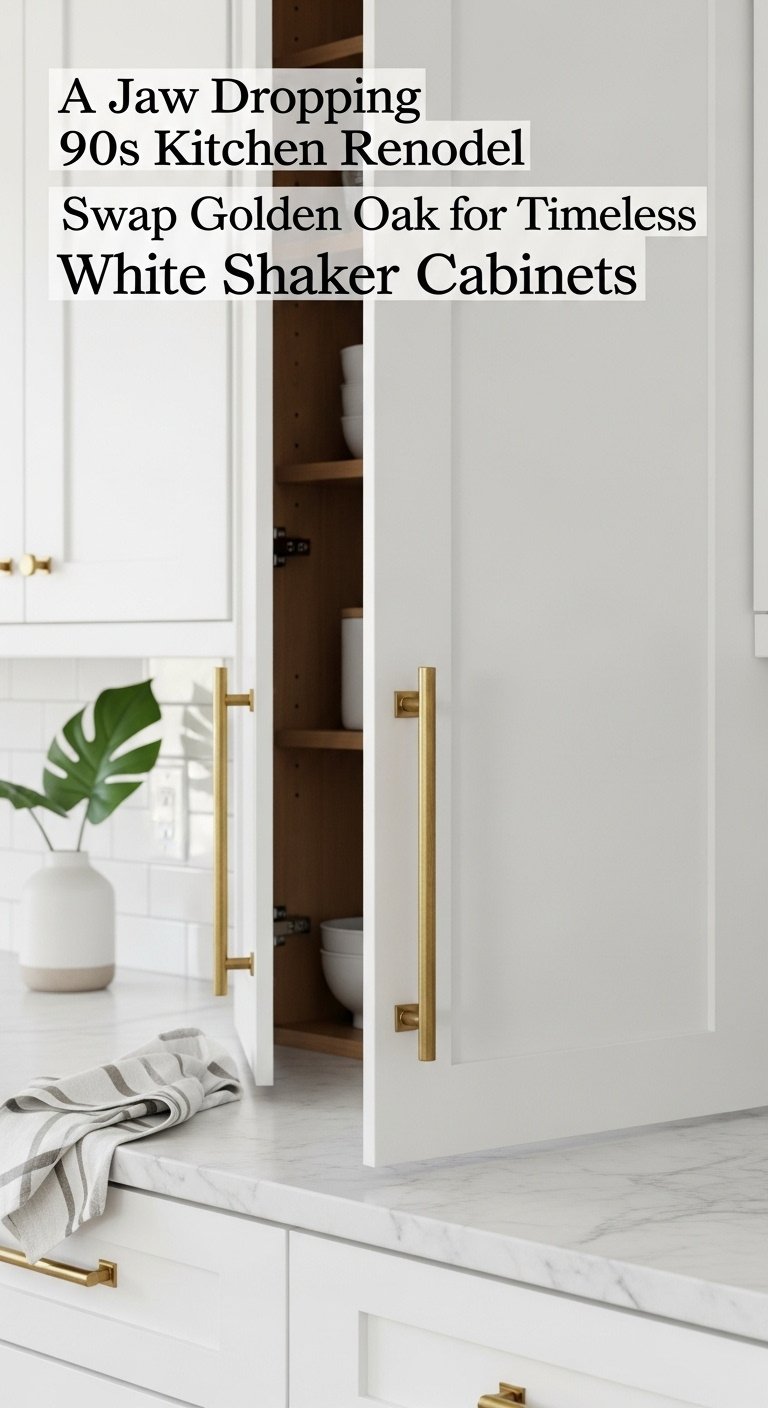
- Materials Needed: New pre-assembled or RTA (ready-to-assemble) shaker cabinets, level, drill/driver, cabinet screws, cabinet hardware (pulls/knobs), shims.
- Step-by-Step Directions:
- Measure and Design: Meticulously measure your kitchen and create a detailed plan for the new cabinet layout. Use online planners or consult with a cabinet supplier to ensure everything fits perfectly.
- Remove Old Cabinets: Gently remove the old cabinets, starting with the uppers. Unscrew them from the walls and from each other. This is a great time to patch and paint the walls.
- Install Base Cabinets: Begin your installation in a corner. Position the first base cabinet, ensuring it is perfectly level and plumb by using shims underneath. Screw it securely into the wall studs.
- Install Upper Cabinets: Use a temporary ledger board—a straight board screwed level into the wall—to support the weight of the upper cabinets as you install them. Lift and secure the upper cabinets to the wall studs.
- Add Hardware: Once all cabinets are installed, drill holes for your new pulls or knobs. Using a hardware template jig will ensure perfect placement every time.
Pro-Tip: For a high-end, custom look, add simple crown molding to the top of your upper cabinets. It’s an inexpensive detail that elevates the entire design and makes a huge difference.
Love this classic look? Save it to your ‘Kitchen Cabinet Ideas’ board!
3. Upgrade to Durable & Chic Countertops
To truly elevate your kitchen, replace dated laminate with a durable, high-quality surface like quartz or granite. These materials not only provide a massive aesthetic upgrade but also offer superior performance, being highly resistant to scratches, heat, and stains, which makes them a worthwhile investment.
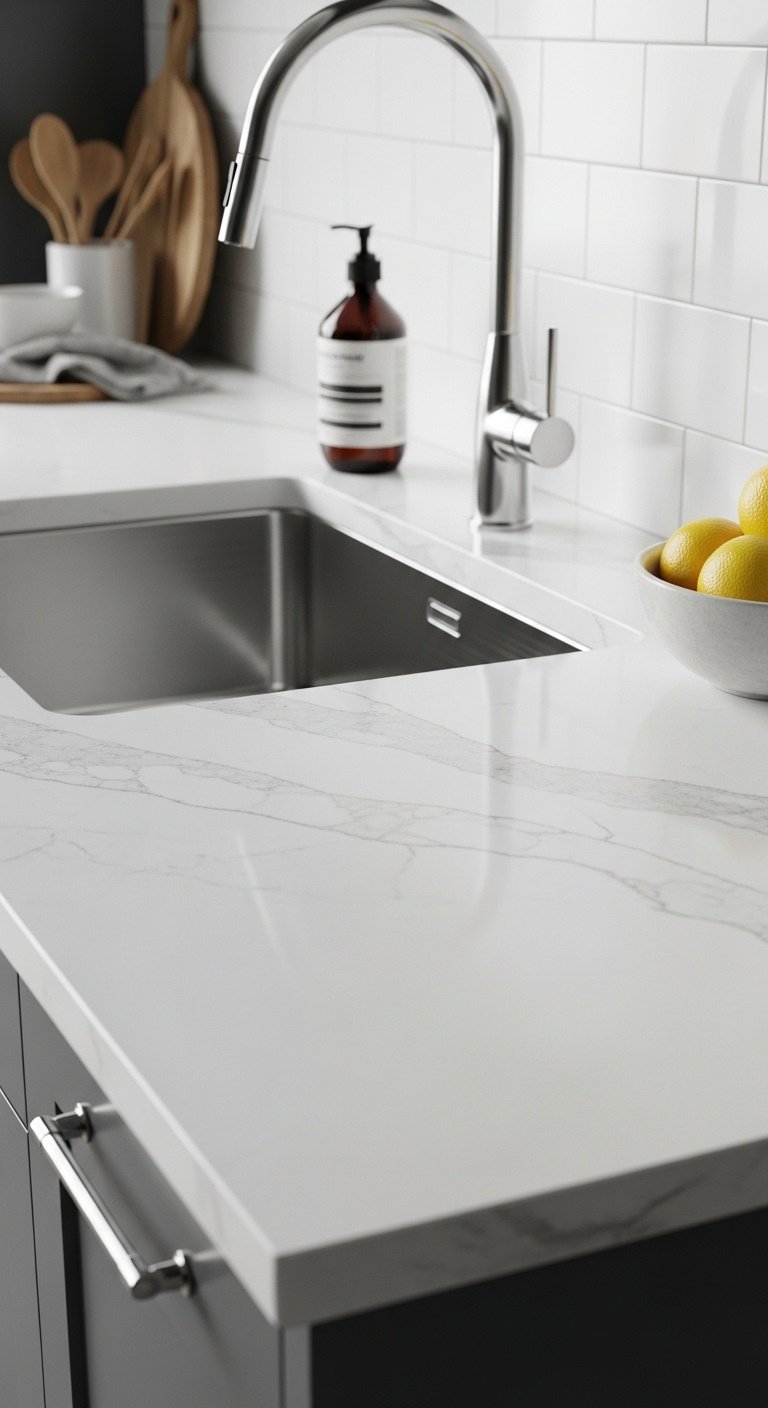
- Materials Needed: Chosen countertop material (e.g., Quartz slab), construction adhesive, silicone caulk, level, shims.
- Step-by-Step Directions:
- Template Creation: A professional fabricator will visit your home to create a precise template of your base cabinets. This ensures a perfect, custom fit for your new countertops. This is not a DIY step.
- Old Countertop Removal: First, disconnect the sink and faucet plumbing. Then, carefully pry off the old laminate countertop, which is often just glued and screwed to the cabinets.
- Check for Level: Before installation, use a long level to ensure your base cabinets are perfectly flat and level. Add shims where needed to create a stable base.
- Dry Fit: Professionals will bring the fabricated countertop and place it on the cabinets without adhesive (a “dry fit”) to confirm the template was accurate and everything lines up perfectly.
- Installation: A bead of construction adhesive or silicone is applied to the top edge of the cabinets. The new countertop is then carefully lowered into place. Any seams between pieces are joined with a color-matched epoxy for a nearly invisible finish.
Lesson Learned: While DIY is great for many projects, countertop installation is best left to professionals. The material is too heavy, cumbersome, and expensive to risk a mistake. The cost of professional installation is worth the peace of mind and guarantees a perfect result.
Share this stunning countertop inspo with a friend who’s remodeling!
4. Install a Classic Backsplash for a High-End Finish
A backsplash is the finishing touch that ties the whole kitchen together. Installing a classic tile like a white beveled subway tile or a Carrera marble mosaic adds texture, protects your walls, and gives the kitchen a polished, high-end feel without a huge expense.
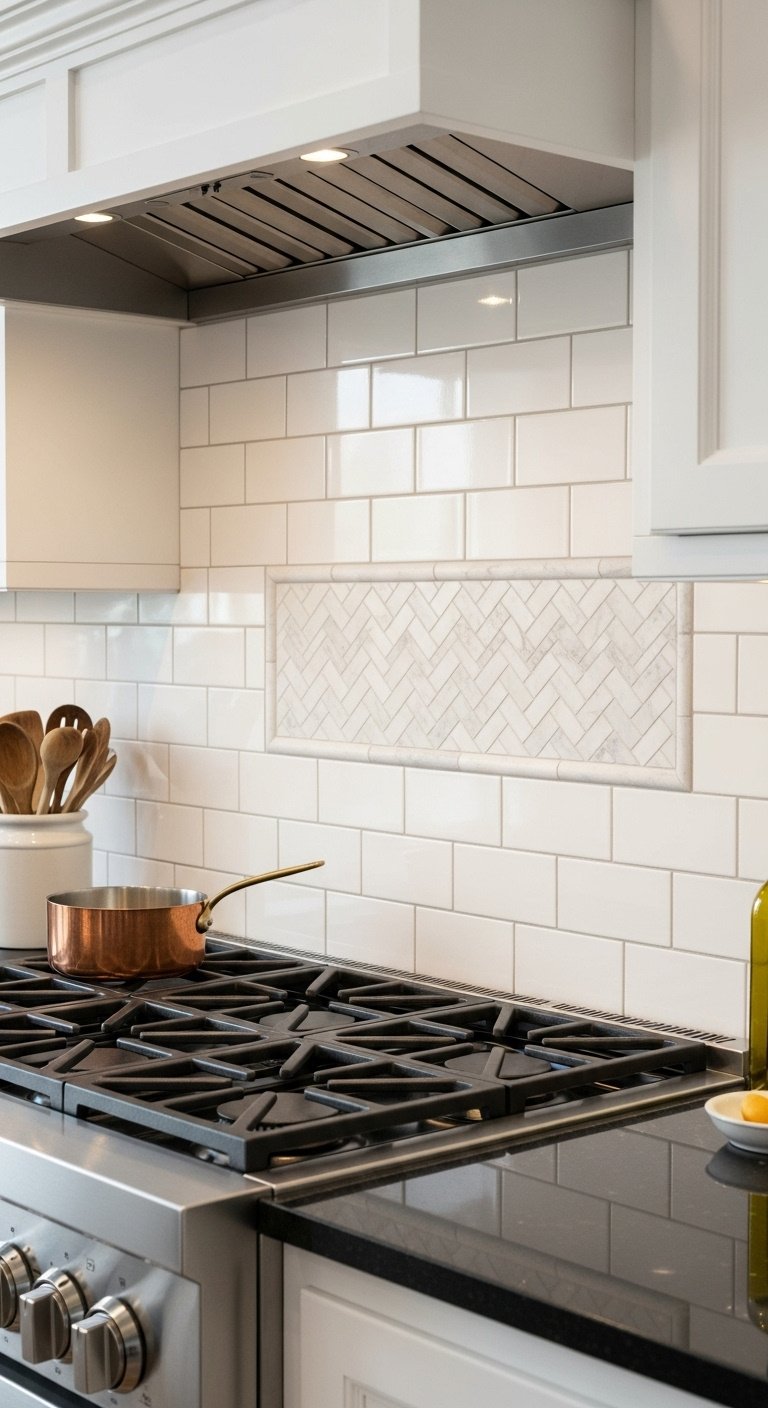
- Materials Needed: Tile, thin-set mortar, notched trowel, tile saw or cutter, tile spacers, pre-mixed or powder grout, grout float, sponge.
- Step-by-Step Directions:
- Prep the Wall: Ensure the wall is clean, dry, and flat. Repair any holes and sand it smooth.
- Apply Mortar: Using the notched trowel, apply a thin, even layer of mortar to a small section of the wall (about 2-3 square feet at a time).
- Set the Tile: Press the first tile into the mortar with a slight twist to ensure good adhesion. Use tile spacers between each tile to maintain consistent gaps for grout. Continue across the row, cutting tiles as needed for the ends with a tile saw.
- Let it Cure: Allow the mortar to dry completely according to the manufacturer’s instructions, which is typically 24 hours. Do not rush this step.
- Grout: Remove all the tile spacers. Apply grout diagonally across the tiles with a grout float, pressing it firmly into all the gaps.
- Clean Up: Wait about 20-30 minutes for the grout to set slightly. Then, use a large, damp sponge to wipe the excess grout off the tile surfaces. Let the grout cure fully, then use a dry cloth to buff away any remaining haze.
Pro-Tip: For a subtle touch of luxury, use a contrasting grout color. A light grey grout with white subway tile makes the classic brick pattern pop without being overwhelming and is more forgiving than stark white.
Click to save this timeless backsplash idea for your own kitchen!
5. Integrate Modern, Panel-Ready Appliances
Upgrading from dated black or white appliances to modern stainless steel or panel-ready models creates a cohesive, high-end look. Panel-ready appliances are designed to be fitted with a custom cabinet front, allowing them to blend seamlessly with your cabinetry for the ultimate integrated and luxurious kitchen.
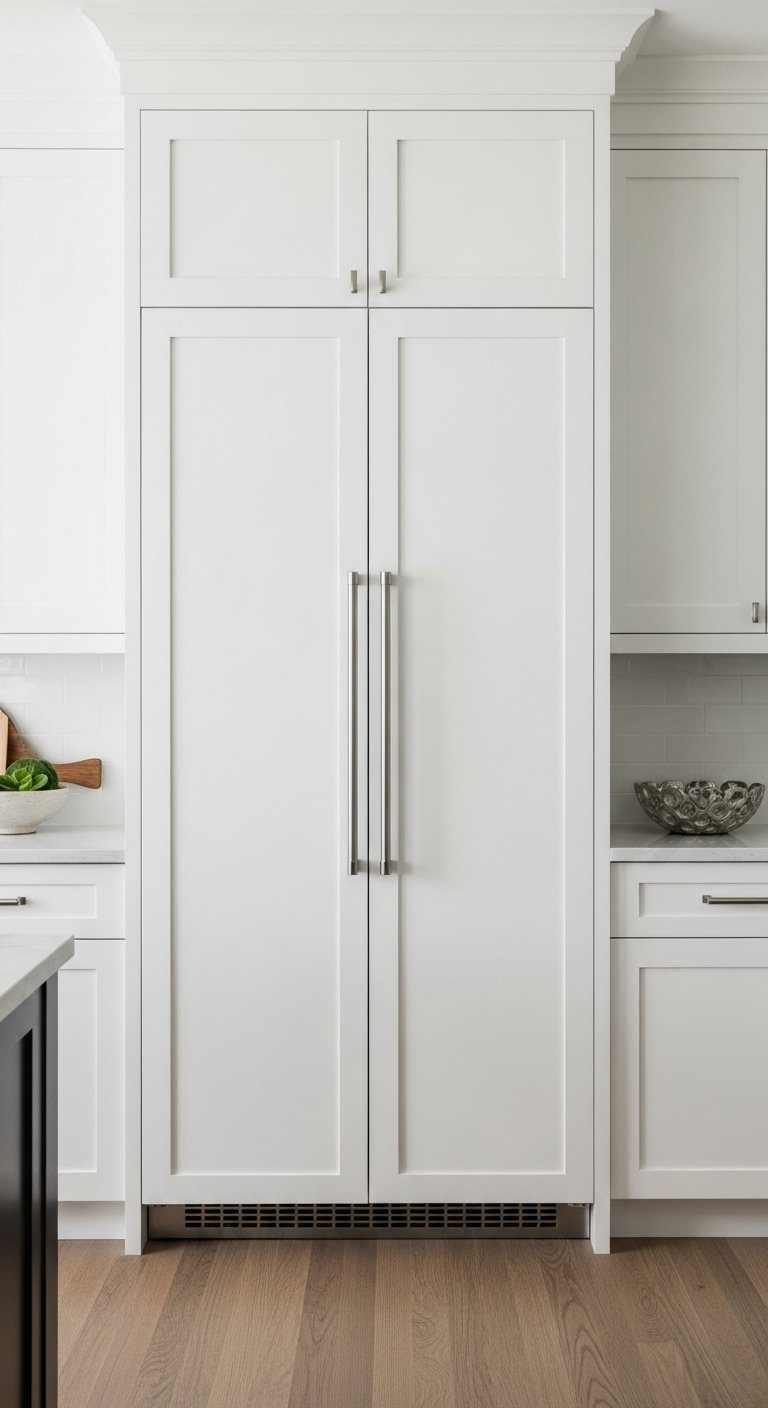
- Materials Needed: New appliances, appliance installation kits, custom cabinet panels (for panel-ready), drill/driver, level.
- Step-by-Step Directions:
- Measure Carefully: Before purchasing anything, measure your appliance openings (height, width, and depth) multiple times. Check the manufacturer’s specifications to ensure a perfect fit.
- Disconnect Old Appliances: Safely unplug the appliance and shut off any gas or water lines connected to it. Carefully slide the old unit out.
- Install New Appliances: Slide the new appliance into its designated space. Use a level to ensure it’s properly balanced and adjust the feet as needed. Secure it to the surrounding cabinetry according to the manufacturer’s instructions.
- Connect Utilities: Reconnect the water lines (for refrigerators and dishwashers), gas lines, and electrical cords. For gas connections, always check for leaks using soapy water on the fittings.
- Attach Custom Panels: For panel-ready appliances, carefully follow the manufacturer’s specific guide to attach your custom cabinet fronts. This usually involves mounting hardware to the panel and then clipping it onto the appliance door.
Lesson Learned: Panel-ready appliances are a splurge, but they elevate the kitchen to a new level of design cohesion. If the budget is tight, prioritize a panel-ready dishwasher first. Since it’s typically located centrally in the base cabinets, hiding it makes the biggest visual impact for the cost.
Pin this high-design secret for the ultimate seamless kitchen!
6. Layer Lighting for Ambiance and Function
Proper lighting is one of the most overlooked aspects of a kitchen remodel. A well-designed kitchen requires layers of light: ambient (overall illumination), task (focused on work areas), and accent (for mood). Replacing a single, central fixture with a combination of recessed lights, pendants, and under-cabinet lighting is a total game-changer.
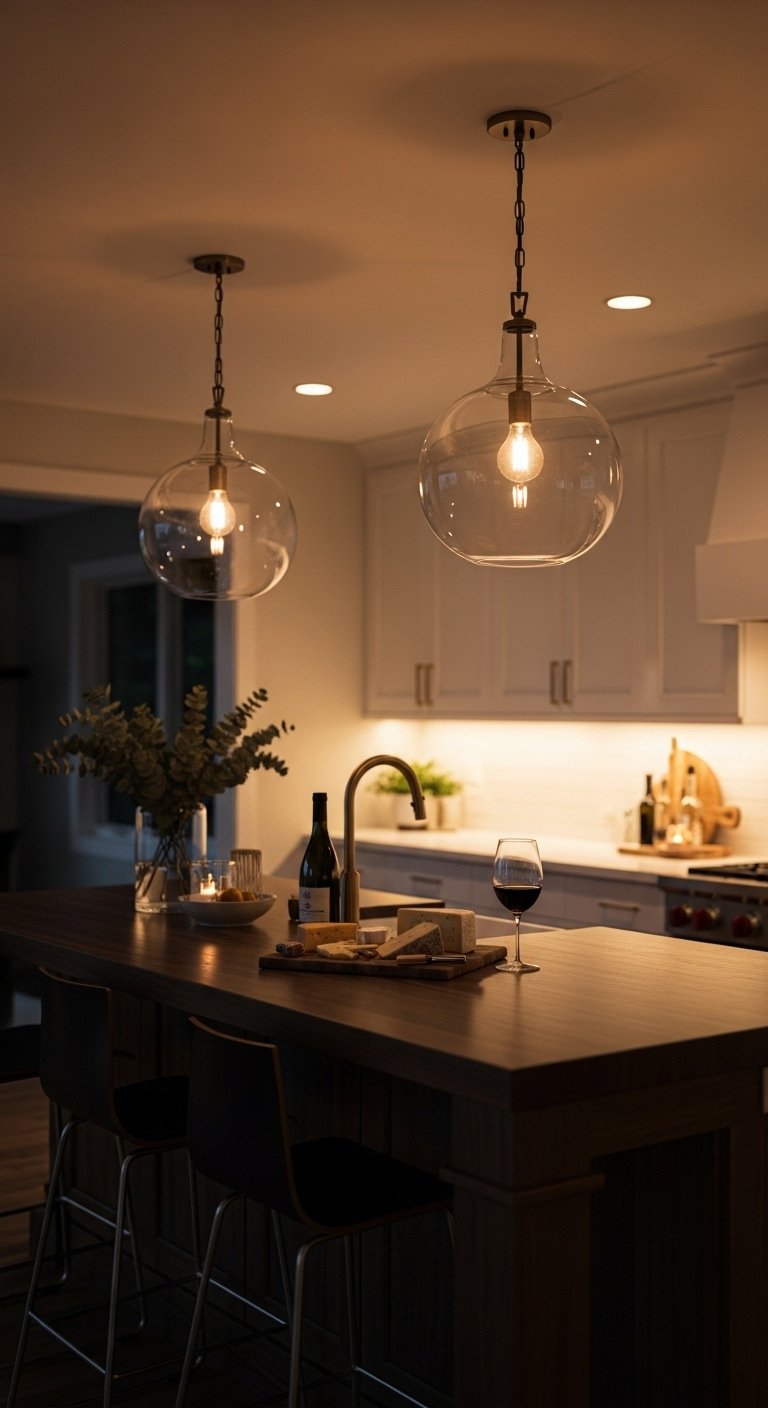
- Materials Needed: Recessed light housings and trims, pendant light fixtures, LED under-cabinet strips, wire cutters, electrical tape, drywall saw.
- Step-by-Step Directions:
- Turn Off Power: This is critical. ALWAYS turn off the power at the circuit breaker before beginning any electrical work.
- Plan Your Layout: Map out the ceiling, planning for recessed lights to provide even, overall ambient lighting. Plan for pendant lights to hang over key areas like an island or sink for accent and task lighting.
- Install Recessed Cans: Use a hole saw to cut openings in the ceiling for the recessed light housings. Run the necessary wiring from the power source to each light location.
- Hang Pendants: Install the mounting bracket for your pendant lights to a ceiling junction box and wire them according to the instructions. Adjust the height so they hang about 30-36 inches above the countertop.
- Add Task Lighting: Install LED strip lighting under the upper cabinets. This is the best way to brightly illuminate your countertop workspace without casting shadows.
- Connect to Switches: Connect all your new lights to wall switches. Use dimmers whenever possible for maximum control over the room’s ambiance.
Pro-Tip: Install dimmer switches on all your kitchen lights. This is the single most effective and inexpensive way to change the mood of the room, from bright and functional for cooking to low and ambient for entertaining.
Save this perfect lighting formula to your ‘Kitchen Design’ board!
7. Select a Bright, Neutral Color Palette
To maximize the light and airy feel of your new kitchen, choose a bright, neutral color palette for the walls. Shades of white, off-white, and light gray create a clean backdrop that makes the space feel larger and allows other design elements, like your countertops and backsplash, to shine.
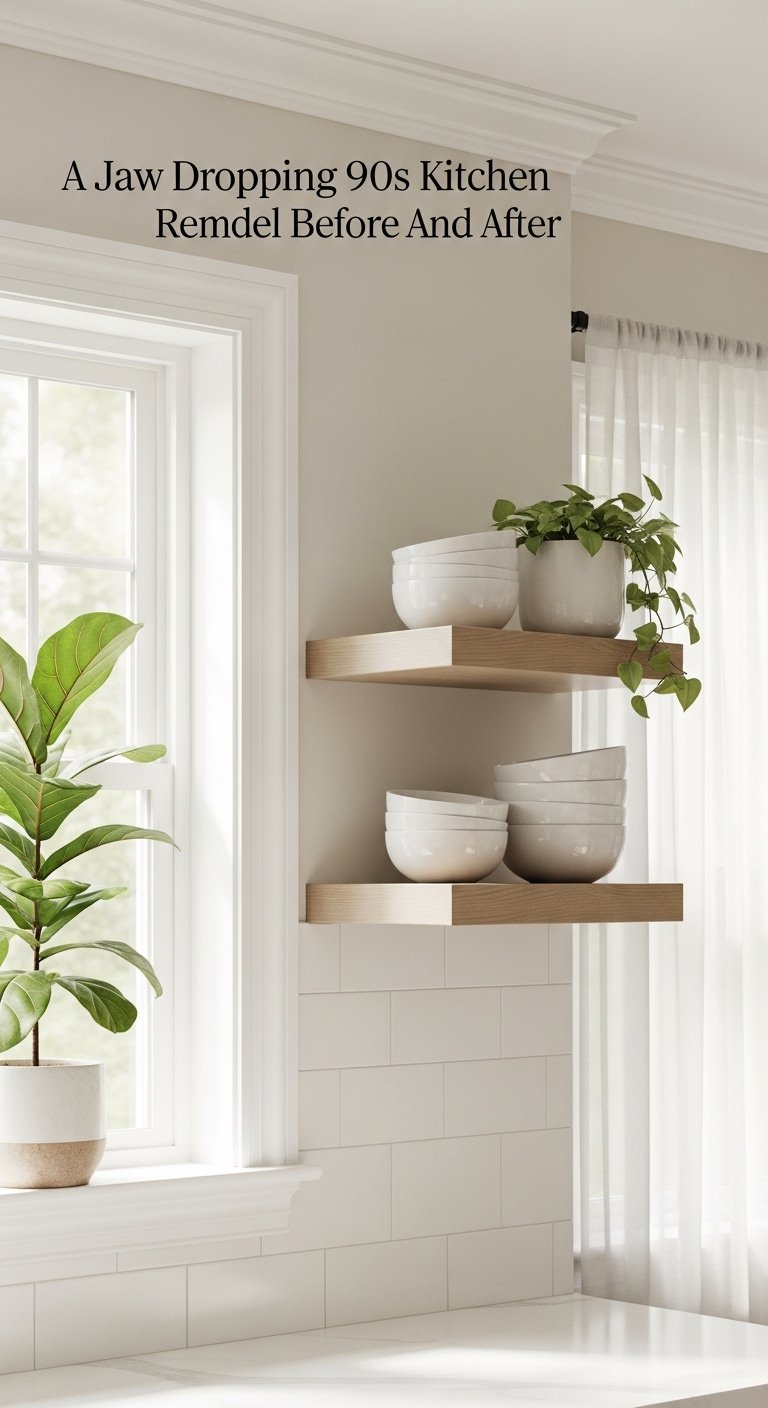
- Materials Needed: High-quality interior paint, primer, paint rollers with extension pole, 2-inch angled brushes, painter’s tape, drop cloths.
- Step-by-Step Directions:
- Prep the Room: Move everything out of the kitchen or to the center of the room and cover it with drop cloths. Clean the walls thoroughly with a TSP substitute to remove any grease or grime. Tape off cabinets, trim, and ceilings.
- Prime the Walls: Apply a coat of high-quality primer. This is especially important if you are covering a dark 90s color like forest green or burgundy to prevent the old color from bleeding through.
- Cut In: Use an angled brush to “cut in,” painting a 2-3 inch strip along the edges of the ceiling, trim, and corners where a roller can’t reach.
- Roll the Walls: Pour paint into a tray and load your roller. Apply the paint to the large wall surfaces in long, even strokes, using a “W” or “N” pattern to ensure the best coverage without roller marks.
- Apply a Second Coat: Once the first coat is completely dry (check the can for recoat times), apply a second coat for a smooth, deep, and consistent finish. Carefully remove the painter’s tape while the second coat is still slightly wet for the cleanest lines.
Pro-Tip: Always test paint samples on your actual walls before committing. A color can look completely different depending on your kitchen’s unique natural and artificial lighting. Paint large swatches on different walls and observe them at various times of the day and night.
Ready to brighten up? Pin these perfect neutral paint ideas!
Key Takeaways: Your Quick Guide to 90s kitchen remodel before and after
Feeling overwhelmed? Don’t be. Focus on these high-impact changes for the most dramatic and satisfying transformation of your 90s kitchen.
- Open Up the Space: Removing non-load-bearing walls or peninsulas is the most dramatic change, creating a modern, open-concept flow that completely alters how you live in your home.
- Focus on Cabinets: Swapping dated golden oak for timeless white shaker cabinets instantly brightens and modernizes the entire kitchen, making it feel brand new.
- Invest in Surfaces: Upgrading from laminate to durable, high-quality countertops like quartz or granite provides the biggest return on investment in both aesthetics and daily function.
- Layer Your Lighting: A combination of ambient (recessed), task (under-cabinet), and accent (pendant) lighting is crucial for creating a space that is both beautiful and highly functional.
- Go Bright and Neutral: A color palette of whites, off-whites, and light grays will make the kitchen feel significantly larger, cleaner, and will beautifully reflect all the new light in the space.
People Also Ask About 90s kitchen remodel before and after
We get a lot of questions about these transformations. Here are answers to some of the most common ones.
How can I update my 90s kitchen without painting the oak cabinets?
To update a 90s kitchen without painting the cabinets, focus on changing the elements around them. Replace old laminate countertops with a light-colored quartz or granite, install a modern white backsplash like subway tile, and update the cabinet hardware to a more modern finish like matte black or brushed brass. Upgrading the lighting to a layered system and painting the walls a bright, neutral color will also significantly brighten the space and tone down the orange of the oak.
What is the most budget-friendly way to remodel a 90s kitchen?
The most budget-friendly approach involves keeping the existing layout and cabinet boxes. You can have the existing oak cabinets professionally painted for a fraction of the cost of new ones. Replace countertops with a more affordable but stylish option like butcher block or new high-definition laminate. You can also install a simple DIY peel-and-stick backsplash and update the flooring with durable and inexpensive luxury vinyl plank (LVP). New hardware and a fresh coat of paint are two of the cheapest, highest-impact changes you can make.
Are golden oak cabinets coming back in style for 2025?
While warmer wood tones and natural wood cabinets are returning to design trends, the specific “golden oak” or “honey oak” finish of the 90s is not making a comeback. That particular finish, characterized by its strong orange/yellow undertones and often paired with arched cathedral-style doors, still reads as dated. The modern take on oak cabinets features a much lighter, more natural, white oak finish in a simple shaker or flat-panel door style.
Final Thoughts
Transforming a dated, clunky 90s kitchen into a bright, functional, and beautiful space is one of the most rewarding home improvement projects you can undertake. It not only increases the value of your home but dramatically improves your daily life, creating a welcoming hub for family and friends. While it can seem like a massive undertaking, breaking it down into these seven key steps makes the process manageable and the goal achievable. Your dream kitchen is closer than you think.
What’s the one feature of your 90s kitchen you’d love to change first? Let us know in the comments below
